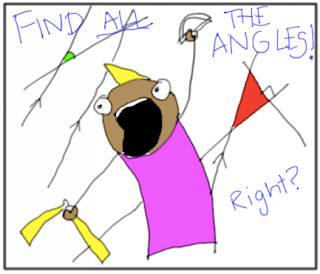(The math is at the end of this one.)
Last week I had one of those teaching collisions where it felt like every idea was dovetailing. First some twitterer retweeted
Terie Engelbrecht's
post on rigor and relevance in the context of motivating students with respect not points. Her post was a riff on this
International Center for Leadership in Education chart. My preservice high school teachers had asked for parallel lines, circles and proof for our geometry topic.
Elissa Miller tweeted about parallel lines in a way that also brought up relevance.
Some comments from my colleague Dave Coffey connected the Relevance framework to the Levels of Transfer, a professional development framework from
Joyce and Showers. Before I switched to a communication framework, I tried to grade using that framework! Very ingenuous, as most students are not at an executive level of transfer, and it is not fair as an expectation for a large quantity of work. I did like the sense of ownership that it promoted, and the encouragement for students to show that they had made the learning their own. When it came time to convert to grades, Integrated Use was an A, and Executive an A+. Is that fair?
Terie's central question was: 'So why not change the "doing the work for points" idea into a "doing the work to improve my learning?" idea?' This has been an issue all semester with this particular group of students for me. Because this is a teaching class, we've even explicitly discussed from whence comes thier lack of responsibility. (As in the Condition of Learning, Responsibility; not as in a guilt trip from your parents. I hope.)

So I brought the framework into class and asked them to classify the kind of lessons they saw in observation... 10 to 15 lessons over the course of the semester. I was seriously surprised how well distributed the X's were on the relevance framework, but not surprised by the low range of rigor. The students discussed how the ABCD was confusing, as D was the "best." They had quite an interesting discussion about whether math should be 'real world' or not. You all know the discussion: why do they ask us (math teachers)? Do they ask their history teacher? What about learning the math for math's sake? Sometimes the applications are so artificial. The students hate the applications so much, why make them do them?
I think, from their discussions as well as their observation journals, I would have put most of their X's in A. The application in the rigor framework led to a lot of the marks being along that line, as we haven't studied Bloom's, nor have they in other classes. Personally, I do wonder about what the classroom should look like in terms of this scale. I like the idea of flexible access, and I want students to transition to analysis, synthesis and evaluation. The application framework seems like you do want a diversity of those problem types. Regardless, I'm really interested in what other teachers think about the framework.
To support the students in thinking about implementing this, I brought what I had thought of after Elissa's prompt. Their task:
Our question is: how can we plan a lesson or lessons that will support our students in moving towards being able to make proofs, understanding the required angle content, and engaging them all the while?
Consider the following and please add your own:
a) a puzzle made from parallels and transversals
b) a map of city streets
c) a classic Japanese problem using these ideas
Where do these ideas fall on the rigor/relevance chart? How should we sequence them or structure class to get to our objective?
Explore the activities in your groups, or design your own, and then we’ll come back together to discuss the ideas.
The puzzle: (Actually revised a bit from their use, based on play; changes were made to make it more accessible and focus on the mathematical properties. Click on the image for full size.)
The map: (Grand Rapids)
Tasks suggested for this were identifying parallel and perpendicular lines, vertical and transversal pairs of angles, combining measurement of street intersections, make informal arguments for congruent pairs, etc.
The Japanese angle problem:
(The top angle is 50 degrees, the bottom 30 degrees.)
Find the angle
x.
“Please solve the problem and if you can make an explanation that is amazing.”
From the TIMSS video at
http://timssvideo.com/66 (Love this problem; thanks to Rebecca Walker who first found it.)
Students tried all three, and they typically wanted a combination of them in their lessons for their hypothetical students. The discussion of rigor in these problems gave us a lot of material (by which I guess I mean gave me a lot of informal assessment data) for a discussion of answer, solution, argument, proof in a later class.
I think these problems are pretty good samples of A, B and C lessons; I confess to being a bit stumped as to what a D lesson/problem/activity might be for this topic. The nature of abstraction in mathematics will lead to a lot of good lessons proceeding from B to C. Opportunities to venture onto D might be more rare. I'm very curious to hear what other people think.






























